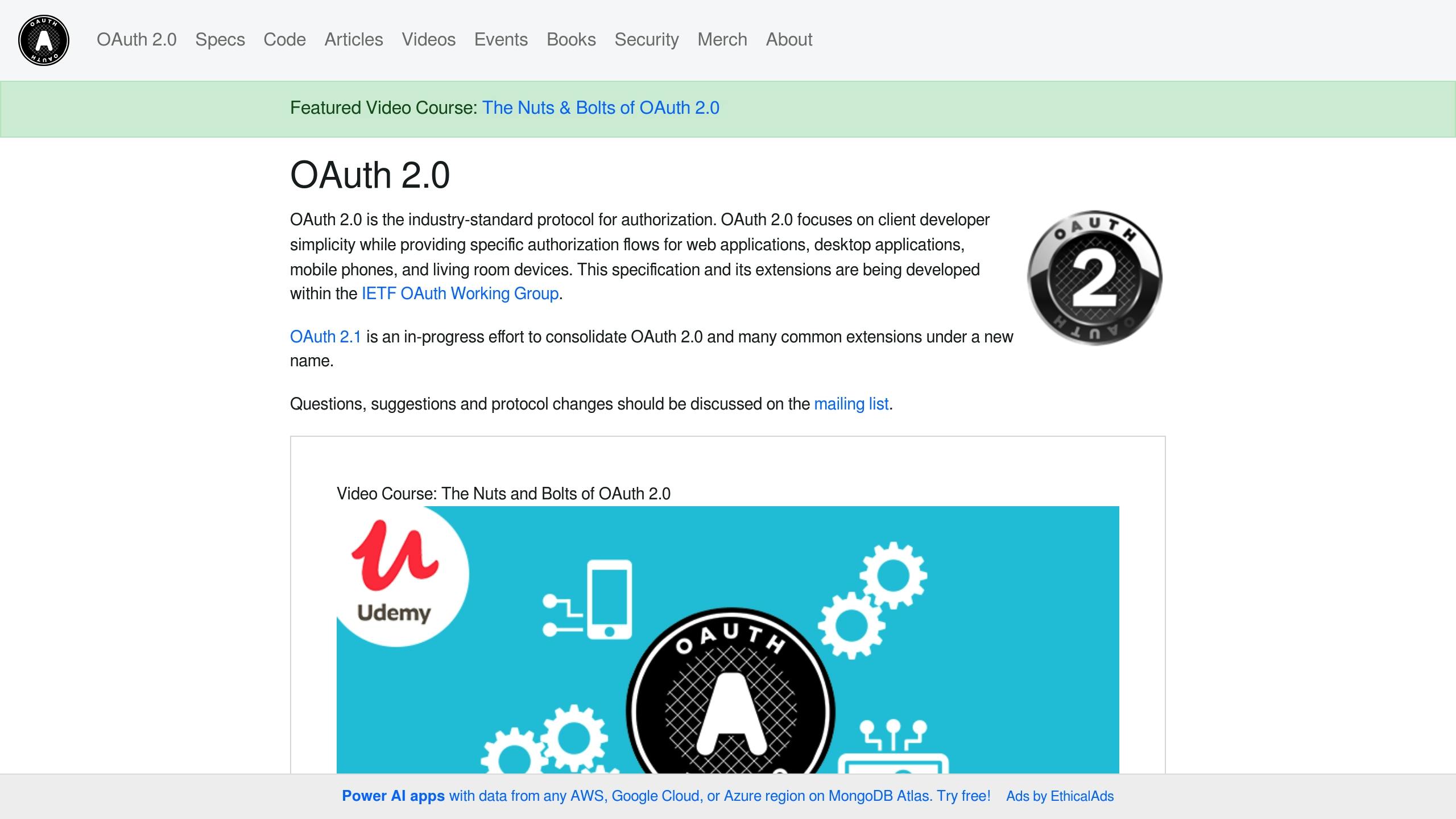OAuth scope naming is critical for securing APIs and simplifying their use. Poorly named scopes can confuse developers and create security risks, while clear, consistent naming ensures precise permissions and easier maintenance. Here’s a quick summary of best practices:
Use Clear, Descriptive Names: Follow a resource.action format like users.read to specify both the resource and action.
Maintain Consistency: Stick to a unified naming pattern across all APIs to avoid confusion.
Balance Detail Levels: Use fine-grained scopes for high-security tasks and coarse-grained scopes for simpler operations.
Prevent Conflicts with Namespaces: Add unique identifiers (e.g., service.resource.action or versioning) to avoid overlaps.
Document Each Scope: Clearly define what each scope does, including permissions, limitations, and examples.
Plan for Updates: Use versioning and gradual deprecation to handle changes without breaking integrations.
Apply Minimal Access: Grant only the permissions necessary for a specific task to reduce risk.
These practices ensure APIs remain secure, organized, and developer-friendly. Platforms like DreamFactory can automate many of these processes, making it easier to implement and maintain proper scope management.
OAuth 2 scope design for security

1. Use Clear, Descriptive Names
When naming OAuth scopes, clarity is key. A good scope name should immediately convey its purpose, helping developers understand exactly what permissions they’re requesting.
To achieve this, follow a consistent resource.action format, such as users.read or transactions.create. This approach specifies both the resource being accessed and the action being performed, ensuring clarity while maintaining uniformity across your API. Here’s how it looks in practice:
|
Naming Convention |
Example Scope |
Description |
|---|---|---|
|
resource.action |
users.read |
View user profiles |
|
resource.action |
transactions.create |
Initiate financial transfers |
|
resource.action |
articles.publish |
Publish content |
Avoid using vague or overly broad terms like full_access, admin, or data. These can lead to excessive permissions being granted, potentially compromising security. Developers might unintentionally request more access than they need, and administrators could struggle to assess whether such access is justified.
When designing scope names, consider the needs of both technical and non-technical stakeholders. For example, a name like financial.reports.read is intuitive and self-explanatory, even for business users reviewing access requests. On the other hand, cryptic abbreviations like fin_rpt_r can create confusion and hinder understanding.
Platforms like DreamFactory demonstrate how clear scope naming enhances security. DreamFactory’s Role-Based Access Control (RBAC) system works in tandem with OAuth scopes, ensuring that descriptive names translate into precise access control. This highlights the importance of thoughtful naming conventions in maintaining secure APIs.
It’s also important to establish naming conventions early and revisit them periodically as your APIs evolve. Including API versions in scope names, such as api.v1.users.read, helps maintain clarity during updates and ensures compatibility over time.
Finally, thorough documentation of each scope is crucial. Clearly outline its purpose, permissions, examples, and any limitations. This not only reduces implementation errors but also supports seamless and secure API integration.
2. Keep Naming Patterns Consistent
Consistency in OAuth scope naming is key to keeping your API ecosystem organized and reducing confusion. When multiple teams work on different services, inconsistent naming can lead to misunderstandings and even security vulnerabilities. A unified naming system makes it easier for everyone - developers, administrators, and new team members - to quickly understand scope permissions, no matter which API they’re working with.
Stick to the resource.action pattern across all services. This means every scope name should follow the same structure, whether it’s for managing users, handling financial transactions, or publishing content. Deviating from this pattern can cause unnecessary delays for developers trying to understand scope functions and make it harder for administrators to evaluate access requests. A consistent naming approach not only simplifies governance but also improves documentation and collaboration across teams.
DreamFactory showcases this principle by enforcing a standardized approach that ensures all teams and applications adhere to the same framework. This reduces the need for custom integrations and makes onboarding new developers much smoother. The same logic applies to OAuth scope naming - when everyone follows the same rules, integrating with your APIs becomes more straightforward.
"Build a single, reusable 'port' to enterprise context. New assistants plug in and work on day one." - DreamFactory
To prevent inconsistencies from creeping into production, establish governance policies and automation tools that enforce your naming rules. These safeguards ensure that as your system grows, every new API or service automatically adopts your established conventions. This approach helps maintain security while speeding up development.
"Every new use case inherits your guardrails automatically, so velocity increases while risk stays bounded." - DreamFactory
Documentation is another critical piece of the puzzle. Provide clear examples and templates that showcase approved naming patterns, common resource types, and standard actions. A centralized style guide should be easily accessible and regularly updated to reflect changes in your API ecosystem. This ensures that all teams stay aligned and maintain the integrity of your OAuth scope naming practices.
Finally, plan for the future by versioning your scopes when necessary. Use patterns like api.v1.users.manage to introduce new functionality while preserving backward compatibility. This forward-thinking approach keeps your ecosystem flexible and prepared for growth.
3. Choose the Right Level of Detail
After establishing clear naming conventions and consistent patterns, deciding on the appropriate level of detail is another key step to secure API access.
When implementing OAuth, finding the right balance between fine-grained and coarse-grained scopes is crucial. If scopes are too detailed, developers may face the challenge of managing an overwhelming number of permissions. On the other hand, overly broad scopes can pose security risks by granting unnecessary access to sensitive data or functions.
Fine-grained scopes operate on the principle of least privilege. For example, instead of assigning a general orders.manage permission, you could break it down into more specific scopes like orders.read, orders.create, orders.update, and orders.delete. This approach gives you precise control over what an application can do, making audits easier and limiting potential damage in case of misuse. However, this method can complicate development and slow down the integration process as developers juggle multiple permissions.
In contrast, coarse-grained scopes bundle related actions under a single scope. For instance, a scope like orders.manage might include permissions for reading, creating, updating, and deleting order data. This simplifies the developer experience by reducing the number of authorization requests during OAuth flows. However, the trade-off is that applications could gain more access than they actually need - for example, an app designed to display order history might unintentionally receive the ability to delete orders.
To strike a balance, experts suggest aligning scope definitions with business domains and isolating high-risk operations - such as payment processing, administrative tasks, or data deletion - into separate, dedicated scopes. Regularly testing and monitoring scope usage, planning for scope versioning (e.g., api.v1.users.manage), and documenting decisions about granularity can further enhance security and usability.
|
Scope Type |
Example |
Best Use Case |
Security Risk |
|---|---|---|---|
|
Fine-grained |
|
High-security environments |
Low – minimal access granted |
|
Coarse-grained |
|
Developer-friendly APIs |
Higher – risk of over-privileged access |
|
Hybrid |
|
Balanced approach |
Moderate – controlled broad access |
A practical example of this balance can be seen in DreamFactory, which auto-generates secure REST APIs with granular permission controls. This ensures integrations only get access to the data and functions they truly need.
4. Use Namespaces to Prevent Conflicts
As your API ecosystem expands, you might find that different services require similar scope names, such as "read" or "manage." When these names overlap, it can lead to confusion and even security risks. This is where namespaces come in - they act as unique identifiers, ensuring that each scope is clearly tied to its specific API or service. Think of namespaces as a way to give each scope its own "address", much like how street addresses differentiate houses with the same number on different streets. For instance, an orders.read scope in your e-commerce API won’t get mixed up with an orders.read scope in your inventory system.
To ensure global uniqueness, structured formats like URI-based (e.g., https://company.com/api/users/read) or URN-based (e.g., urn:company:scope:users:read) are often used. These formats are particularly helpful in managing distributed systems. On the other hand, smaller or internal systems might find a simpler dot notation - such as service.resource.action - to be sufficient.
When choosing a namespace format, consider the scale of your organization. Larger systems with global reach benefit from unique identifiers, while smaller setups can stick to straightforward conventions. Adding version indicators, like api.v1.users.manage or api.v2.users.manage, can also prevent conflicts when updating or evolving your API.
Here’s a quick comparison of namespace strategies:
|
Namespace Strategy |
Format Example |
Best Use Case |
Ensures Uniqueness |
|---|---|---|---|
|
Dot Notation |
|
Single organization, multiple APIs |
Clear hierarchical separation |
|
URI/URN-based Format |
|
Distributed systems, multi-tenant |
Globally unique identifiers |
|
Versioned Hierarchy |
|
APIs with multiple versions |
Version-specific scope isolation |
|
Flat with Prefixes |
|
Simple systems with few services |
Service-level prefix separation |
To keep things organized, make sure to document your namespace rules. For example, platforms like DreamFactory automate namespace management when generating secure REST APIs, ensuring scopes are correctly isolated across various services and database connections. This eliminates the risk of manual configuration errors.
Additionally, maintain an explicit scope list that maps each namespace to its corresponding API endpoints. This practice not only helps avoid conflicts during development but also ensures clarity for your team. Include concrete examples of scope values for each namespace and establish clear guidelines for when to create new namespaces versus extending existing ones. Proper documentation is your long-term ally in keeping your API ecosystem conflict-free.
5. Document Each Scope's Purpose
After establishing clear naming conventions, it's equally important to document each OAuth scope in detail. Why? Because documentation transforms these scopes into well-defined, actionable permissions, making API access easier to understand and more secure. When developers know exactly what a scope does, they can use it appropriately without unnecessary guesswork.
For each scope, include details like its purpose, the permissions it grants, any limitations, and practical usage examples. This clarity helps prevent overly broad permission requests and ensures developers can select just the right level of access for their needs.
Take the scope orders.read as an example. With proper documentation, developers know it provides read-only access to order details - such as order history, status, and items - while explicitly stating that it cannot create, update, or delete orders. This level of detail not only improves usability but also strengthens security by encouraging minimal access permissions.
Clear documentation also provides other benefits. It creates an auditable trail that supports compliance requirements and simplifies onboarding for new developers. By clearly defining what each scope does - and doesn't do - you can better assess risks tied to various permission levels and make smarter decisions about access control.
Here’s a quick breakdown of how effective documentation can make a difference:
|
Documentation Element |
Example |
Developer Benefit |
|---|---|---|
|
Purpose Statement |
|
Makes the scope's function clear |
|
Endpoint Mapping |
|
Speeds up implementation with specific endpoints |
|
Security Implications |
|
Highlights security requirements upfront |
|
Dependencies |
|
Explains relationships and dependencies between scopes |
Using tools like OpenAPI specifications can streamline this process. OpenAPI allows you to define scopes directly in your API documentation, ensuring that permissions stay aligned with your actual implementation as your API evolves. This reduces the risk of inconsistencies and keeps your documentation accurate over time.
For an even easier solution, platforms like DreamFactory offer automated documentation generation. This eliminates the need for tedious manual updates, ensuring that your scope documentation remains reliable and up to date. By investing in accurate and detailed documentation, you not only enhance the developer experience but also lay the groundwork for secure and efficient API usage.
6. Plan for Changes and Updates
Once you've established clear naming conventions and thorough documentation, it's time to think ahead. Planning for scope changes is crucial as your API grows and evolves. New features, updated permissions, or retired functionality often require scope updates, and handling these changes thoughtfully can prevent breaking integrations.
The cornerstone of managing scope changes is versioning paired with structured deprecation procedures. For example, if you’re updating a scope, you might introduce a versioned scope like users.v2.manage while keeping the older users.v1.manage for existing clients. This approach ensures backward compatibility and aligns with the principles of consistency and clarity.
Backward compatibility should always guide your decisions. Avoid altering the purpose of existing scopes. For instance, if orders.read was designed to provide access to basic order details, don’t expand it to include sensitive payment information. Instead, create a new scope, like orders.payment.read, to handle the additional permissions. This keeps your API predictable and avoids unexpected access issues for developers.
Communication plays a big role in managing scope changes effectively. When deprecating a scope, notify developers well in advance through API documentation and direct updates. Clearly mark deprecated scopes in your documentation and provide detailed migration guides, including examples to help developers transition smoothly. As we’ve discussed before, accurate documentation is a critical part of this process.
Tracking scope usage is another essential step. Monitoring which scopes are actively used - and by how many applications - helps you identify candidates for deprecation and ensures you don’t disrupt heavily-used integrations. This data-driven approach also helps you prioritize support for migration efforts.
|
Change Management Strategy |
Implementation |
Developer Impact |
|---|---|---|
|
Versioned Scope Names |
|
Provides a clear upgrade path with minimal disruption |
|
Gradual Deprecation |
Announce changes 6 months in advance |
Gives developers time to plan and migrate |
|
Usage Monitoring |
Analyze scope usage data before making changes |
Reduces the risk of breaking critical integrations |
When deprecating a scope, follow a structured timeline. Announce the deprecation early, provide a transition period (typically several months), and only remove the old scope after ensuring minimal active usage. During the transition period, keep the deprecated scopes fully functional while encouraging developers to migrate to the newer versions.
Tools like DreamFactory can simplify this process by automatically updating your API documentation as scopes evolve. This minimizes the manual effort required to keep your documentation synced with your API, ensuring developers always have access to accurate and up-to-date information.
7. Apply Minimum Required Access
Continuing our discussion on managing scope changes, implementing the principle of minimum required access is another critical layer in strengthening API security.
This approach ensures that each scope grants only the permissions absolutely necessary to perform a specific task. By limiting access in this way, the potential damage from a compromised token is significantly reduced.
Since scopes are the core of OAuth2's authorization mechanism, every scope you design should answer one key question: What is the smallest level of access required to complete this task?
To achieve this, isolate high-risk operations into their own narrowly defined scopes. For example, sensitive actions like account deletion, payment processing, or administrative functions should each have dedicated scopes. A users.delete scope, for instance, should be separate from users.read or users.update. This ensures that routine tasks don’t inadvertently allow destructive actions.
Using broad scopes like admin.full can expose your system to unnecessary risk, while more specific scopes like reports.view help limit potential damage. A great example of this principle in action is GitHub’s OAuth implementation. Their repo scope grants full control over private repositories, but the more granular repo:status scope restricts access to commit statuses only. This level of detail allows developers to request just the permissions they need for a specific use case.
|
Access Level |
Example Scope |
Purpose |
|---|---|---|
|
Read-only |
|
Data retrieval |
|
Write |
|
Creating resources |
|
Manage |
|
Full CRUD operations |
|
Admin |
|
Administrative functions |
Resource servers also play a vital role in enforcing these limitations. Even after initial token validation, your server should confirm that the token’s scope permits the requested action. This extra layer of verification prevents scope creep and keeps permissions tightly controlled.
Avoid the temptation to create catch-all scopes for convenience. While an api.full scope might seem efficient, it conflicts with the principle of minimal access by granting unnecessary permissions. Instead, provide clear documentation to help developers understand exactly which scopes they need for their specific tasks.
Regularly monitor scope usage to identify and eliminate over-permissioned tokens. By reviewing actual usage patterns, you can fine-tune permissions and ensure no scope grants more access than required.
If a client omits the scope parameter altogether, your authorization server should either apply a restrictive default or reject the request outright. Always ensure tokens are issued with only the permissions necessary for the task at hand.
DreamFactory exemplifies this approach with its built-in security controls. By enforcing precise access limits, DreamFactory ensures that every request adheres to strict guardrails, reducing risk while still giving developers the flexibility to build effective applications.
Ultimately, defining thoughtful scope boundaries is key to balancing security and usability. Group related actions logically to avoid excessive fragmentation, but avoid bundling unrelated permissions into a single scope. By adhering to the principle of minimum required access, developers can request only the permissions they need, reinforcing a secure and efficient API design strategy.
Comparison Table
Here's a concise summary of the trade-offs between fine-grained and coarse-grained scope approaches. These distinctions can help guide your decisions when designing API scopes.
Fine-grained scopes focus on specific actions, offering tighter control. For instance, instead of a single scope like users.manage, you might define users.read, users.create, and users.delete. This approach supports the principle of least privilege, limiting access to only what’s necessary.
Coarse-grained scopes, on the other hand, group related permissions into broader categories like users.manage or admin.all. While this simplifies implementation for developers, it increases potential risks if a token is compromised.
Here’s a quick comparison:
|
Aspect |
Fine-Grained Scopes |
Coarse-Grained Scopes |
|---|---|---|
|
Security Level |
Higher (enforces least privilege) |
Lower (greater risk of over-permission) |
|
Developer Complexity |
More challenging to implement |
Easier to work with |
|
Maintenance Overhead |
Harder to manage as scopes increase |
Simpler, fewer scopes to maintain |
|
Access Precision |
Highly specific |
Broader, less precise |
|
Token Risk |
Limited damage if compromised |
Greater exposure if leaked |
|
Documentation Needs |
More detailed and complex |
Simpler but less specific |
When to Use Fine-Grained Scopes
Fine-grained scopes are ideal for sensitive operations, such as managing financial transactions, modifying user data, or performing administrative tasks. They’re particularly important for APIs dealing with personal data, healthcare information, or payment processing, where security is paramount.
When Coarse-Grained Scopes Work Best
Coarse-grained scopes suit simpler APIs or internal systems where all users share similar access needs. They’re also a good fit for rapid prototyping or scenarios where ease of use takes precedence over granular control.
Combining Both Strategies
Many APIs successfully mix these approaches. For example, fine-grained scopes can secure high-risk operations, while coarse-grained scopes handle routine, low-risk tasks. This hybrid strategy balances security and simplicity.
Ultimately, your choice depends on your team’s resources and priorities. Fine-grained scopes demand more planning and maintenance but offer stronger security. For smaller teams or less critical systems, coarse-grained scopes may be more practical.
Platforms like DreamFactory showcase how to strike this balance effectively, offering detailed access control where necessary while keeping routine operations straightforward. These principles are key to building secure and sustainable APIs.
Conclusion
Effective OAuth scope naming is a cornerstone of building secure and maintainable API architectures. The seven best practices we've discussed work together to ensure clear security boundaries, a smooth developer experience, and manageable maintenance.
Ignoring these principles can lead to serious issues. Poorly named scopes can result in over-privileged applications, confused developers, and security vulnerabilities that are both hard to identify and fix. On the other hand, well-thought-out scope design acts as a safety net, protecting your data while supporting valid use cases.
Providing detailed documentation for each scope - covering its purpose, usage, and limitations - is key to secure API access. Additionally, setting up versioning conventions helps maintain backward compatibility and protects existing integrations.
Platforms like DreamFactory bring these best practices to life by automating secure API access with built-in safeguards. This approach ensures controlled access, consistent governance, and a clear audit trail. With a 4.7 rating on G2, DreamFactory exemplifies how to balance security, clarity, and seamless integration.
"DreamFactory acts as a secure, on-premises data plane and policy-aware gateway that applies guardrails and governance to every API request. The platform simplifies consistent application of access policies by ensuring that governance travels with every request, and every new use case inherits guardrails automatically - increasing velocity while bounding risk".
"DreamFactory's approach to OAuth scope management exemplifies the balance between security and usability. It provides measured access and explainable outcomes, ensuring that every API action is bounded by defined policies and leaves an auditable trail".
As your API evolves and the security landscape shifts, OAuth scope naming requires regular review and fine-tuning. This ongoing process helps ensure your API remains secure and adaptable over time.
FAQs
Why is it crucial to use consistent naming for OAuth scopes across APIs?
Maintaining uniform naming for OAuth scopes across APIs plays a key role in improving clarity, ease of use, and security. When scope names follow a consistent pattern, developers can more easily understand and work with your API, minimizing the chances of mistakes or misunderstandings. This approach also establishes a predictable framework, which is especially valuable when managing multiple APIs or collaborating across different teams.
On top of that, using clear and standardized scope names strengthens security by reducing the risk of misinterpreting permissions. When scope names are straightforward and follow a logical structure, it becomes much simpler to convey the level of access they provide. This helps both users and developers make well-informed decisions when it comes to authorization.
When should I use fine-grained scopes versus coarse-grained scopes in my API design?
When deciding between fine-grained and coarse-grained scopes, it all comes down to the level of control and flexibility you want to offer your API users.
With fine-grained scopes, you can define highly specific permissions, giving precise access to individual resources or actions. This approach is perfect when your API caters to a wide range of use cases or when strict access control is a top priority.
In contrast, coarse-grained scopes bundle permissions into broader categories. While they’re easier to manage and implement, they don’t offer the same level of flexibility. This makes them a good fit for simpler APIs or scenarios where ease of use outweighs the need for detailed control.
For most APIs, a mix of both works best. Use fine-grained scopes where precision and security matter most, and rely on coarse-grained scopes for less sensitive or general operations. And don’t forget - clearly documenting your scopes is key to helping users understand their purpose and limitations.
How can I effectively manage and update OAuth scopes as my API grows and changes?
To keep your OAuth scopes organized and up-to-date as your API evolves, clarity and consistency should be your guiding principles. Group similar actions into logical categories, and choose names that are straightforward and easy for developers to interpret. Steer clear of overly broad or vague scopes, as they can introduce security vulnerabilities or unintended usage.
When making updates to scopes, aim to maintain backward compatibility to avoid disrupting existing integrations. It's also crucial to communicate any changes effectively - provide clear documentation and set deprecation timelines. This ensures developers have the information and time they need to adjust without interrupting their workflows.
Kevin McGahey is an accomplished solutions engineer and product lead with expertise in API generation, microservices, and legacy system modernization, as demonstrated by his successful track record of facilitating the modernization of legacy databases for numerous public sector organizations.
























 Blog
Blog



